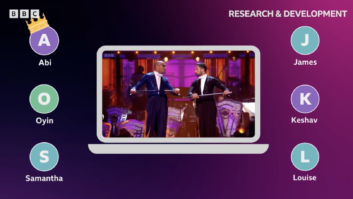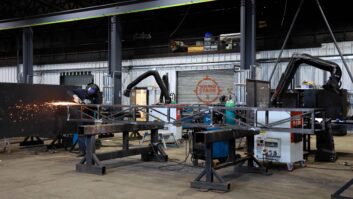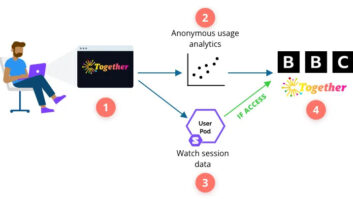BBC Research & Development and Red Bee Media have received a Queen’s Award for the pioneering Piero sports graphics system, writes David Fox.
Piero is a TV graphics system that is used for analysis and has transformed sports broadcasting. It lays graphics over the TV pictures and gives sports presenters or pundits another way to view and analyse crucial incidents in the games, and explain them more effectively to the audience.
The work that led to Piero began at BBC R&D with the Prometheus project that started in 1999, one part of which allowed assumptions about perspective and depth of field to be taken from a single camera, so that when the images of individual players were extracted from the background, they could be placed correctly in a virtual view of the stadium. This became Piero, which went on air for the first time during Match of the Day on September 25th, 2004.
It has since been developed and licensed internationally by Red Bee Media, but BBC R&D has added further technology, such as a method to track camera movement using image analysis. The Queen’s Award for Enterprise: Innovation 2011 has been jointly awarded to both organisations for their work on the system. It is the highest official UK award to British businesses for outstanding achievement.
Piero has since featured in global sports events such as RBS Six Nations rugby and football World Cups.
This weekend a beta-version of its volleyball package will be used for the first time, by TV Globo, Brazil.
It is now used in more than 40 countries, leading to 90% of its revenue coming from exports. At last year’s World Cup in South Africa over 85% of all analysis effects used in the world feed came from the Piero system. European users include: various parts of Canal+, ITV, Sky Italia, Digiturk, Viasat Sport and Sat 1.
Piero creates a virtual stadium, which is synchronised to the feed from the TV cameras. Pictures of the players are transposed into the virtual image, where it is possible to view and analyse the game from different angles in animated sequences, allowing incidents to be assessed from the best angle. The system can also render graphics such as distance markings so that they appear tied to the pitch.
Just the beginning
While Piero continues its development at Red Bee Media, the BBC R&D team that originally created it are now working on much more advanced technology that takes the Piero concept forward and could be available to viewers live rather than just being used for post-match analysis.
TVBEurope talked to Matthew Postgate, the BBC’s Controller of Research & Development, about its long-term project to mix computer-generated imagery with captured imagery. “Piero was just the beginning of that journey,” he explained.
It is now “exploring the idea of capturing data sets and not just video,” to create “new tools for us to tell stories with. The possibilities are quite exciting.”
The additional data could include such things as depth of field, geolocation data and ambient lighting, all of which would combine to drive a service that could offer viewers much more information about what they are seeing.
“It’s more the concept rather than being restricted by video and post production as we are at the moment. If we’re able to capture video as data, we will be able t to deconstruct this as if viewed from a different angle.”
It could allow viewers to follow a single player, or merge together material from the archive with a live event, “comparing what’s happened in the past with what’s happening live. There are lots of creative possibilities.”
It would require much more complex algorithms and far more processing power than Piero, but “this line of thought is a direct descendent of the Piero system.” It will allow users to “manipulate the graphics and the video footage itself more radically,” intermingling the graphics and video much earlier in the process, so that it would be available for a whole match and not just for a few sequences.
The research is a long-term project that could take another five years.
www.bbc.co.uk/rd/
www.redbeemedia.com/piero
BBC Research & Development and Red Bee Media have received a Queen’s Award for the pioneering Piero sports graphics system, writes David Fox.
Piero is a TV graphics system that is used for analysis and has transformed sports broadcasting. It lays graphics over the TV pictures and gives sports presenters or pundits another way to view and analyse crucial incidents in the games, and explain them more effectively to the audience.
The work that led to Piero began at BBC R&D with the Prometheus project that started in 1999, one part of which allowed assumptions about perspective and depth of field to be taken from a single camera, so that when the images of individual players were extracted from the background, they could be placed correctly in a virtual view of the stadium. This became Piero, which went on air for the first time during Match of the Day on September 25th, 2004.
It has since been developed and licensed internationally by Red Bee Media, but BBC R&D has added further technology, such as a method to track camera movement using image analysis. The Queen’s Award for Enterprise: Innovation 2011 has been jointly awarded to both organisations for their work on the system. It is the highest official UK award to British businesses for outstanding achievement.
Piero has since featured in global sports events such as RBS Six Nations rugby and football World Cups.
This weekend a beta-version of its volleyball package will be used for the first time, by TV Globo, Brazil.
It is now used in more than 40 countries, leading to 90% of its revenue coming from exports. At last year’s World Cup in South Africa over 85% of all analysis effects used in the world feed came from the Piero system. European users include: various parts of Canal+, ITV, Sky Italia, Digiturk, Viasat Sport and Sat 1.
Piero creates a virtual stadium, which is synchronised to the feed from the TV cameras. Pictures of the players are transposed into the virtual image, where it is possible to view and analyse the game from different angles in animated sequences, allowing incidents to be assessed from the best angle. The system can also render graphics such as distance markings so that they appear tied to the pitch.
Just the beginning
While Piero continues its development at Red Bee Media, the BBC R&D team that originally created it are now working on much more advanced technology that takes the Piero concept forward and could be available to viewers live rather than just being used for post-match analysis.
TVBEurope talked to Matthew Postgate, the BBC’s Controller of Research & Development, about its long-term project to mix computer-generated imagery with captured imagery. “Piero was just the beginning of that journey,” he explained.
It is now “exploring the idea of capturing data sets and not just video,” to create “new tools for us to tell stories with. The possibilities are quite exciting.”
The additional data could include such things as depth of field, geolocation data and ambient lighting, all of which would combine to drive a service that could offer viewers much more information about what they are seeing.
“It’s more the concept rather than being restricted by video and post production as we are at the moment. If we’re able to capture video as data, we will be able t to deconstruct this as if viewed from a different angle.”
It could allow viewers to follow a single player, or merge together material from the archive with a live event, “comparing what’s happened in the past with what’s happening live. There are lots of creative possibilities.”
It would require much more complex algorithms and far more processing power than Piero, but “this line of thought is a direct descendent of the Piero system.” It will allow users to “manipulate the graphics and the video footage itself more radically,” intermingling the graphics and video much earlier in the process, so that it would be available for a whole match and not just for a few sequences.
The research is a long-term project that could take another five years.







